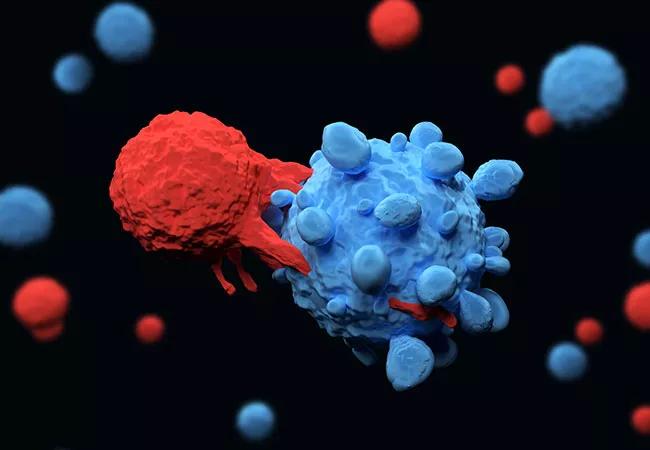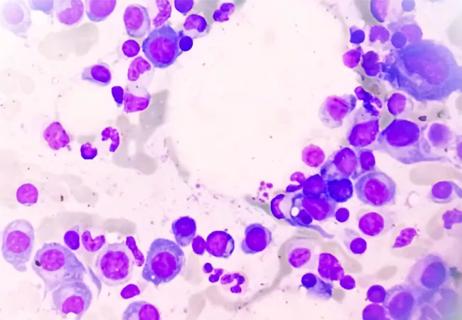Dispelling myths and sharing practical experiences

Chimeric antigen receptor (CAR) T-cell therapy has entered the mainstream for treating patients with certain blood cancers, such as multiple myeloma and some types of lymphoma and leukemia. This treatment has primarily been administered at specialized academic centers, resulting in a lack of familiarity among community hospitals about this novel therapy. Today ConsultQD (CQD) sat down with Cleveland Clinic Director of the Blood & Marrow Transplant program Craig Sauter, MD, to hear about the clinic’s experience with CAR T-cell therapy for patients with diffuse large B-cell lymphoma (DLBCL).
Advertisement
Cleveland Clinic is a non-profit academic medical center. Advertising on our site helps support our mission. We do not endorse non-Cleveland Clinic products or services. Policy
Dr. Sauter: In the case of large B-cell lymphoma, it can be approached with the intent to cure with a one-time treatment. That potentially may also be the case with acute lymphoblastic leukemia. That being said, it cures roughly one in three patients at best.
Dr. Sauter: For some patients with adequate fitness and a caregiver at home, we can try to treat them on an outpatient basis. Half of those patients will have no demonstrable toxicities that would require hospital admission. For patients receiving the CD28 costimulatory products such as axicabtagene ciloleucel or brexucabtagene autoleucel, we typically treat them in the hospital because those products are associated with higher rates of CRS with at least a fever in the setting of neutropenia, as well as greater risk of ICANs. The hope is that they are in the hospital no longer than 7-10 days.
Dr. Sauter: We approach it on a case-by-case basis. For patients with lymphomas, particularly large B-cell lymphoma, we know we can administer with intent to cure. As we’ve gained more experience, we feel more comfortable bringing in patients who may be older or have comorbidities, because clearly the lymphoma is the biggest risk to their life.
Dr. Sauter: There’s a hypothesis that at least 20-25% of instances of relapse occurs due to CD19 antigen escape. Otherwise, we know that patients with large volume disease tend to have poor prognosis with CAR T-cell therapy. And then there’s the question of T-cell fitness, particularly in patients that have been heavily pretreated or who are older, and whether that may be a prognostic factor.
Advertisement
Dr. Sauter: Many of us believe the single largest prognostic factor is the amount of disease that’s on board at the time of CAR T-cell infusion and treatment. Developing effective bridging or cytoreduction strategies is likely to improve the prognosis of patients proceeding to CAR T-cell therapy, so it’s actually the therapy utilized before the CAR T-cell therapy that’s also important.
Dr. Sauter: In practice, many have used polatuzumab vedotin, either in combination with Bendamustine or rituximab as per the label or as a single agent because it is FDA approved. Many of us are more hesitant towards Loncastuximab because it targets CD19 prior to CAR T-cell therapy. Using Tafasitamab and Lenalidomide is another strategy, but this also targets CD19.
Beyond that, there’s really not much. Selinexor is FDA approved but with very modest response rates and very poor tolerance related to gastrointestinal toxicity. If a patient is eligible for a clinical trial, we encourage that because there may be a novel agent that they would respond to.
Dr. Sauter: There has been conflicting evidence about dose response. I don’t think that question has been answered by the large studies that led to FDA approval of the commercially available CAR T-cell products, because they are administered within a specific dose range.
Dr. Sauter: There is encouraging data about a CD22 autologous CAR-modified T-cell product specifically for patients for whom CAR T-cell targeting CD19 failed. That study was initially conducted at a single center at Stanford University. We’re very excited to be participating in the multi-center phase 2 research here at Cleveland Clinic, hopefully by this summer.
Advertisement
Dr. Sauter: For the CD22-directed therapy, that will be based on the eligibility criteria of the trial. There are two major hurdles many of those patients deal with: Performance status due to resistant lymphoma as well as previous treatment, and prolonged cytopenias, which can be a side effect of CAR T-cell therapy.
There have been multiple studies out of North America and Europe looking at hematologic toxicity in the wake of CAR T-cell therapy. Some patients experience significant prolonged cytopenias, particularly thrombocytopenia and neutropenia. That makes finding a treatment option challenging for patients who don’t have a durable response to the commercially available CAR T-cell therapy.
Dr. Sauter: Emerging evidence from the ZUMA-7 study of patients who failed the investigational arm in the second line shows that those patients do very poorly. In the contemporary era, this therapy has tended to be the last line. The majority of those patients will not be eligible for clinical studies based on performance status and/or cytopenias.
There are indications that newly-developed bispecific T-cell engaging antibodies such as Epcoritamab or Glofitamab may be an optimal salvage strategy, but even in those cases, fewer than half of patients will respond to therapy. So it’s an area that should be targeted for rigorous investigation. Particularly now that there are two CAR-modified T-cell products approved in the second line, we need to better understand what the strategy should be for those patients. Many will be platinum chemotherapy agent naïve. Whether they can tolerate standard of care platinum agents in combination with rituximab is an open question.
Advertisement
Dr. Sauter: Elise Chong, MD at the University of Pennsylvania is studying checkpoint inhibitors targeting PD1 axis. We do know that this reinvigorates expansion of CAR T cells, but what remains to be seen is whether this actually translates into improved efficacy or deepening of response.
Dr. Sauter: In the patient population with DLBCL who achieve complete remission for at least 9-12 months, the vast majority will stay in remission. Patients who progress early tend to have worse outcomes. That is consistent with other DLBCL treatments, including traditional first- and second-line chemo/immunotherapy approaches.
Dr. Sauter: If they are truly effective for 20+ percent of patients who experience antigen escape, that would be a win, but that needs to be proven.
Dr. Sauter: Possibly. We have to understand that a lot of the dual targeted CAR-T therapies also target CD20, for which most patients receive CD20-directed therapy ubiquitously with initial treatment with rituximab, so there may be a select patient group that is CD20 negative proceeding to CAR T-cell therapy. We would have to determine if that is prognostic or if that has any impact on CD20-directed therapy. We know in retrospect from the Zuma-1 study that patients that were CD19 negative going into therapy did not appear to do worse. That’s a very small patient population. Many of us believe that if they lost the targeted antigen that we would not pursue that targeted therapy, but that would need to be proven in a prospective study.
Advertisement
Dr. Sauter: Depending on the CAR T-cell product, CRS can occur in anywhere from 50-90% of patients, but for the vast majority of patients that’s a simple fever in the setting of low blood counts. The vast majority of those cases are amenable to treatment with anti-IL therapy with tocilizumab or siltuximab, and are reversible within days, even hours.
Dr. Sauter: The incidences of neurotoxicities are quite variable depending on the CAR T-cell product as well as the patient’s burden of disease. It could be severe in upwards of 30-40 percent of cases with axicabtagene ciloleucel or brexucabtagene autoleucel, because there’s a CD28 costimulatory molecule. For the other CAR T-cell products for lymphomas and multiple myeloma, the risk of severe neurological toxicity is much lower.
Dr. Sauter: Yes, the vast majority of cases are reversible. In some instances, grade 5-related neurological deaths have been reported, though that is quite rare.
Dr. Sauter: That has not been correlated. We know that patients with more disease tend to have more toxicity. The ideal patient is likely someone with minimal disease, because their prognosis is optimized in that setting compared to a patient with a lot of tumor bulk.
Dr. Sauter: There was a fear early on that administration of anti-L6 therapy and corticosteroids could blunt the efficacy of the CAR product. We don’t believe that is the case. We know from the ZUMA-1 later cohorts of axicabtagene ciloleucel that early intervention with steroids did not appear to impact response rates. However, that was a small number of patients, and we still don’t know if durability is impacted.
Dr. Sauter: We’re better at early intervention for toxicity, and keeping patients out of intensive care units, particularly with CD28 co-stimulatory molecule products like axicabtagene ciloleucel, but in terms of durability and robustness of data for either prevention or early intervention with steroids, I believe many of us feel that we need to see more data.
Dr. Sauter: We would encourage community physicians to try to identify poor-risk lymphoma patients early and make us aware of them. There’s a high likelihood that patients with double hit biology or high tumor burden may not do well with chemo immunotherapy induction, and so we need to move quickly. With autologous CAR T-cell products, there are still logistical hurdles that result in timing delays to therapy.
Dr. Sauter: Within DLBCL, we can administer CAR T-cell therapy expeditiously, but there are still insurance approvals that have to occur, apheresis slots to secure, patient cells to be shipped off and manufacturing and quality control processes that need to take place. The additive effect of that time can be significant for an aggressive lymphoma. Referring patients earlier can help to streamline assessment and hopefully get treatments to patients earlier.
Dr. Sauter: It’s based on many factors, including the patient profile, the availability of the product and the side effect profile of the CAR T-cell therapy.
Dr. Sauter: The next most exciting novel agents that are going to eventually get FDA approval – likely within this calendar year – are bispecific T-cell engaging antibodies such as Glofitamab and/or Epcoritamab, amongst others A study looking at the CAR T-cell Registry in Europe showed that CAR T-cell efficacy appears to be retained, even with previous bispecific T-cell-engaging antibody treatment, which is encouraging. Then the question will become, how do we sequence these therapies, before or after CAR T-cell therapy?
Contact us at bmtcoordinator@ccf.org to request a CAR T-cell therapy consult.
Advertisement

Age alone should not rule out patients from potentially curative treatment

Higher type 2 immunity observed in persistent CAR T cells

Real-world study shows high response rates that are durable with commercial lisocabtagene maraleucel

Minimal residual disease testing shows promising results

Early results show patients experiencing deep and complete response

The latest evidence to support ‘practice-changing’ protocol—and a note of caution

Study measures real-world outcomes for relapsed or refractory large B-cell lymphoma

Optimized responses in transplant- and CAR T-cell therapy-eligible patients